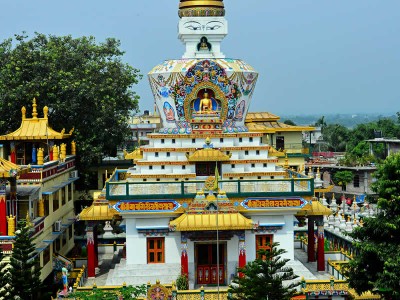Siliguri Travel and Tourism Guide
It is the main commercial city of the North Bengal and its importance comes from its strategic location near international and state borders. It is situated on the banks of the river Mahananda. Spread across the foothills of the Himalayas, it is an important transport, trading and educational centre.
From 1878 the railway route to Siliguri was north for 185 km on the broad-gauge. In 1881 the meter-gauge was joined at Siliguri. In 1915 two new narrow-gauge lines were added to the DHR from Siliguri, to the north-east up the river Teesta valley towards Kalimpong and Sikkim and to the south-west. Also in 1915 the Hardinge Bridge was built across the river Ganges, and in 1926 the meter-gauge north of the bridge was converted, so the whole Calcutta - Siliguri route became broad-gauge.
With the partition of India with religion as the primary consideration in 1947, the broad-gauge route from Calcutta was severed, since part of it ran through East Pakistan, now Bangladesh. This also cut off India’s province of Assam from the rest of the Indian railway network. The route to Siliguri became more circuitous: broad-gauge (Calcutta - Barsoi), meter-gauge (Barsoi - Kishanganj), and narrow-gauge (Kishanganj - Siliguri). In 1949 Kishanganj - Siliguri was converted from narrow-gauge to meter-gauge and extended north-east into Assam. This duplicated part of the narrow-gauge Teesta Valley line, and after a washout in 1950 it was not repaired. The North Bengal Railway route from Calcutta, truncated by partition, had become an isolated section of broad-gauge (Siliguri - Haldibari), so this stub was converted back from broad-gauge to meter-gauge. From about 1949 a new Siliguri Junction station, north of Siliguri Town, became the main station in the area, with three meter-gauge lines (south-west to Kishanganj and Barsoi; north-east to Assam; south to Siliguri Town and Haldibari) and two narrow-gauge lines (north to Darjeeling; south to Siliguri Town). The narrow-gauge steam shed was moved from Siliguri Town to Siliguri Junction and the narrow-gauge Siliguri c - Siliguri Town section became freight-only.
In the early 1960s a more radical change was made. Indian Railways created a new broad-gauge rail link from Calcutta, and on a green field site south of Siliguri Town built an entirely new through broad-gauge station, New Jalpaiguri. The new broad-gauge route continued from New Jalpaiguri east and for more than 10km used the formation of the Haldibari line, so the New Jalpaiguri - Haldibari section was converted yet again - from meter-gauge to broad-gauge for the second time, its fourth incarnation! New Jalpaiguri became a triple-gauge station, being served by the meter-gauge in the shape of the Siliguri Town - New Jalpaiguri section of the former Haldibari line, suitably realigned but not regained, and by a new Siliguri Town - New Jalpaiguri extension of the narrow-gauge DHR. From about 1964 New Jalpaiguri became the main station in the area, with two broad-gauge lines (west to Calcutta; east towards Assam with branch to Haldibari), a meter-gauge line (north to Siliguri Town and Siliguri Junction, diverging thence south-west to Kishanganj and Barsoi, and north-east to Assam) and a narrow-gauge line (north to Siliguri Town, Siliguri Junction and Darjeeling). The narrow-gauge steam shed was again moved, from Siliguri Junction to New Jalpaiguri. With interchange between main-line and Darjeeling trains at New Jalpaiguri, the narrow-gauge New Jalpaiguri - Siliguri Town - Siliguri Junction section became a passenger line. The layout is again changing, for the 1949 meter-gauge route to Assam is also being converted to broad-gauge. In early February 2003 meter-gauge track had been lifted, and broad-gauge track was being laid, from New Jalpaiguri north through Siliguri Town and Siliguri Junction at least as far as the bridge over the river Teesta. For the moment, Siliguri Junction retains one meter-gauge line (south-west to Kishanganj and Barsoi) and two narrow-gauge lines (north to Darjeeling; south to Siliguri Town and New Jalpaiguri) but the future of what is now a Barsoi - Kishanganj - Siliguri Junction meter-gauge branch must be uncertain since for some 150km it runs virtually parallel to the broad-gauge main line, which has been doubled since the late 1980s. When broad-gauge arrives at Siliguri Junction, it would be possible to concentrate interchange.








